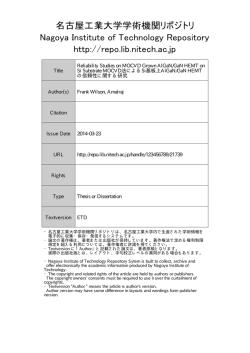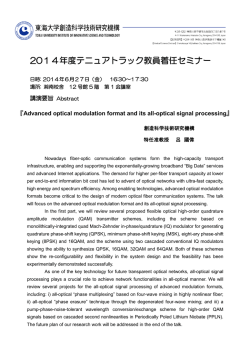
Innovative component technology to support the mission of
The 27th Microelectronics Workshop(MEWS27) Innovative component technology to support the mission of Advanced Land Observing Satellite-2 Oct. 24th. 2014 Hideki SARUWATARI ALOS-2 Project Team, JAXA Today’s contents 1. Outline of ALOS-2 Mission and System 2. Innovative component technology to support ALOS-2 3. System Initial Checkout Status 4. Summary 2 1. Outline of ALOS-2 Mission and System 3 About ALOS Star Tracker 恒星センサ(STT) Data Relay and Communication データ中継衛星通信部(DRC) GPS antenna GPSアンテナ PALSAR Solar Paddle ・Observable range:870km ・revisit cycle :5 days ・Disaster monitoring ・Crustal movement ・Resource survey PALSAR フェーズドアレ イ方式 Lバンド合成 開口レーダ (PALSAR ) PRISM パンクロマチック 立体視センサ (PRISM) AVNIR-2 高性能可視近赤外 放射計2型 (AVNIR-2) PRISM ALOS-2 •highly accurate digital surface model(DSM) ・Cartography ALOS Characteristics Launch Date : Jan. 24, 2006 Spacecraft Mass : Approx. 4 tons Generated Power : Approx. 7 kW (at End of Life) Design Life : 3 - 5 years Orbit : Sun-Synchronous Sub-Recurrent Altitude : 691.65km Inclination : 98.16゚ Period : 98.7minutes Repeat Cycle : 46days(Sub Cycle 2days) Local time at descending node : 10:30am±15minutes ・ Observable range :70km ・High resolution: 2.5m PALSAR-2 AVNIR-2 ・ Observable range :1,520 km ・ revisit cycle :3 days ・Regional Observation 4 ALOS-2 Mission • Disaster Monitoring (Secure the public safety) – Fast access to damaged areas and continuous monitoring – In-SAR data necessary for deformation forecast/monitoring • Land Monitoring (Preserve and manage national land) – based upon archived data • Agricultural Monitoring (Facilitate food supply) – necessary for evaluation of irrigated rice • Natural Resource Exploration (Facilitate natural resources and energy supply) – necessary for detecting oil and mineral resources in the ground and seabed • Global Forest Monitoring (Resolve global-level environmental issues) – global monitoring of tropical rain forests to identify carbon sinks 5 Improvement from ALOS ALOS ALOS-2 Recurrent cycle 46 days 14 days Observable range 870km 2320km (Right looking) (Left & Right looking) Spatial Resolution Downlink 10m (Stripmap) 1-3m (Spotlight), 3m/6m/10m (Stripmap) 138Mbps (X-band) & Data Relay Satellite 800Mbps (X-band) & Data Relay Satellite 6 ALOS-2 ALOS-2 in-orbit configuration Y Specification L-band SAR (PALSAR-2) Stripmap: 3 to 10m res., 50 to 70km swath ScanSAR: 100m res., 350km/490km swath Spotlight: 1×3m res., 25km swath Orbit Sun-synchronous orbit Altitude: 628km Local sun time : 12:00 +/- 15min Revisit: 14days Life time 5 years (target: 7 years) Mass 2,082kg (incl. fuel) Generated Power : 5140W(EOL) Battery Capacity : 200Ah(100Ah x 2) Battery Type : Li-ion X Z Data relay antenna Solar Arrays L-band SAR antenna X-band downlink antenna Power Observation Duty 50%(approx. 48min) Downlink X-band: 800Mbps(16QAM) 400/200Mbps(QPSK) Ka-band: 278Mbps (QPSK) Mission Data Capacity : 128GByte(EOL) Storage (G = 2^30) 7 2. Innovative component technology to support ALOS-2 8 Key technologies Key technologies: •GaN HEMT •CGA mounging technology •High Speed SerDes (Gigabits class) Important component technolgies: •HR5000S •POL (Point-Of-Load) “Development Status of JAXA Point-Of-Load DC/DC converter”, 22nd MEWS, 2009 9 “Current status of MPU development for space”, 22nd MEWS, 2009 PALSAR-2 needs huge performance improvement • PALSAR-2 antenna has 1080 radiating elements fed by 180 Transmit/Receive Modules (TRMs). 10 GaN HEMT for TRMs • The TRM has high efficiency and high power performance by using Gallium Nitride (GaN) High Electron Mobility Transistor (HEMT). GaN V pol PALSAR ALOS-2 H pol HPA GaN HEMT Si BJT Tx power 34W 25W Units 180 80 Efficiency 35% 25% Noise Figure 2.9dB 2.9dB TRM size[mm] 200×110×14.6 203×117×23.5 TRM weight 400g 675g “The overview of the L-band SAR onboard ALOS-2”, 27th ISTS, 2009 “High Power L-band T/R Module utilizing GaN HEMT”, 24th MEWS, 2011 11 High performance mission data handling system is necessary MOD FPGA (CGA package) PALSAR-2 antenna PALSAR-2 ELU Other components Serializer / Deserializer 800 Mbps max Data recorder (MDP) 800/400/200 Mbps 277 Mbps X-band downlink antenna transponder X-band Multimode Highspeed Modulator (XMOD) KMOD Data rely antenna transponder 12 MOD FPGA for high speed data transmission • High speed SRAM-type FPGA was adopted for base band modulation (MOD FPGA). • MOD FPGA is CGA (Column Grid Array) package type which JAXA first adopted. 33mm – Low CTE PWB (Copper Invar Copper) was adopted – Mounting , inspection process was established 33mm <Bottom View of the CGA package> “Development of an X-band Multi-mode High speed Modulato”, ISTS 2011 13 High speed Serializer/Deserializer (SerDes) • High speed SerDes was adopted for interface between MDP and XMOD. • JAXA adopted SerDes device for the first time. – radiation sensitivity was evaluated – transmission performance was tested MDP XMOD Data Max 8 Para (800Mbps) Deserializer Serializer K-code 8ch CLK 100MHz Data Max 8 Para (800Mbps) CLK 100MHz <Interface between MDHS and XMOD> “Development of an X-band Multi-mode High speed Modulato”, ISTS 2011 14 3. Summary of Initial Operation Results 15 Launch Operation of ALOS-2 ALOS-2 was successfully launched by the H-IIA Launch Vehicle No.24 on Saturday May 24th, 2014 (Japan Standard Time, JST) from the Tanegashima Space Center. Satellite / PAF Installation Satellite /Fairing Installation Fairing /Rocket connection Launch 16 Critical Phase Operation 27th May, 2014, the early orbit phase so-called “critical phase” of ALOS-2 had completed. 17 PALSAR-2 Antenna Deployment -Package deploymentThe stowed antenna panels were released from mission structure by pyrotechnics firing. No.3 antenna Mission Structure PALSAR-2 No.3 antenna the eyesight of deployment camera 18 PALSAR-2 Antenna Deployment -Wing deployment- No.1 No.2 No.3 No.4 No.5 Mission Structure No.5 antenna No.1 antenna No.2 antenna No.4 antenna 19 Initial Checkout of ALOS-2 Initial checkout of ALOS-2 was completed. PALSAR-2 performance GPS Receiver, Reaction Wheel, Star Tracker SAP power generation, Bus power control X-band antenna and Data relay antenna pointing Data downlink by X-band QPSK(200Mbps/400Mbps), 16QAM(800Mbps) Data Relay communication via DRTS by Ka-band QPSK(278Mbps) Now! 4 5 △ Launch 6 7 △ PALSAR-2 First image 2014 8 9 10 11 12 △ Product publication Bus Check out PALSAR-2 Check out Calibraton 20 The first image of ALOS-2 th (June 20 , 2014) Mt.Fuji : Ultra-Fine mode (res.3m, Off nadir 40.6 deg) : Red HH, Green HV, Blue HH/HV 21 Remarkable improvement on PALSAR-2 Urayasu image by : JERS-1 / PALSAR / PALSAR-2 JERS-1 Resolution :18 m PALSAR Resolution :10 m PALSAR-2 Resolution :3 m 22 Remarkable improvement on PALSAR-2 Jumeirah Village Circle, Dubai (1/2) 23 Remarkable improvement on PALSAR-2 Jumeirah Village Circle, Dubai (2/2) 24 Disaster monitoring application ALOS-2 emergency observation images of Mt.Ontake After eruption Before eruption A basin was observed after eruption 2014/09/28 12:45(JST) 2014/08/18 23:58(JST) 25 High duty observation PALSAR-2’s high duty observation capability, which is realized by the GaN HEMT, was confirmed during initial checkout. Satellite Freqency Band ALOS-2/PALSAR-2 L TerraSAR-X CosmoSkyMed RADARSAT2 X X C Continuous Observation Time 48 minutes (50% duty) 3 minutes 10 minutes 15 minutes 26 High rate mission data downlink High rate mission data downlink capability was confirmed during initial checkout. Measured constellations of XMOD’s three mode shows mission data can be transferred to ground stations without any problem. Data rate of 800Mbps for X-band is the world’s highest level in the single carrier modulation system. Constellation for X-band transmission 800Mbps(16QAM) 400Mbps(QPSK) 200Mbps(QPSK) 27 4. Summary 28 Summary ALOS-2 succeeds to ALOS’s mission with enhanced capabilities. ALOS-2 was successfuly launched on 24th, May 2014 and the initial checkout was completed. The checkout results shows ALOS-2’s remarkable performances. The initial Cal./Val. phase is on-going. PALSAR-2 products will be released at the end of November. ALOS-2’s remarkable performances are supported by innovative component technologies. 29 大地にも精密検査が必要だ The Earth needs a health check 人間に、健康診断があるように。 地球には、だいち2号がある。 感覚だけでは決してわからない、小さな数値の異常を 健康診断が教えてくれるように。宇宙から地球を精密検査して、 地上にいてはわからない、大地や海の変化を送り続ける。 それが、だいち2号のミッションです。 私たちの足下で、大地は今日も動き、変化しています。 地震、火山噴火、土砂崩れ。災害だけではなく人の手による自然破壊 も原因。 地球の健康を維持するために、宇宙から精密に診断する。 それは未来の、私たちの子孫のためにも、必要なことなのです。 30 30
© Copyright 2025

